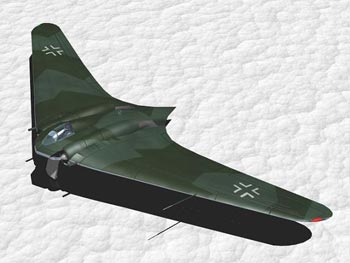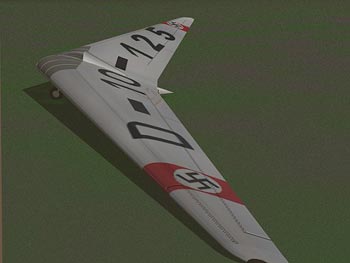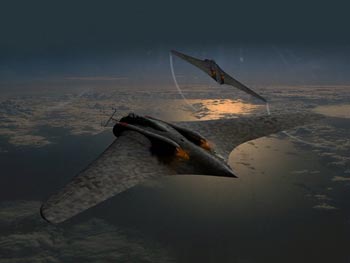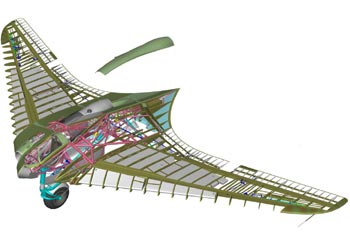The Brothers Horten and Their Wings
Article Type: Military HistoryArticle Date: March 19, 2007
by Jim "Twitch" Tittle
The Brothers Horten and Their Wings
We all know that Walter, Wolfram and Reinmar Horten designed what we know today as the Ho 9 flying wing. It was advanced thinking for a powered aircraft but it was borne out from successful glider layouts dating back to 1934 with the Ho 1.
 |
| Ho 229 Flying Wing. Image by Mario Marino. Copyright date unknown. |
Wolfram died in his He 111 in 1940 but his brothers went on to establish Horten Flugzeugbau GmbH in Bonn, Germany. In 1938 however the Ho 2 glider was flown by Hanna Reitsch who favorably reported that the craft could not be stalled or spun. As the center section stalled the wigs continued to fly.
The Ho 3 followed with a motor driven pusher propeller. The Ho 4, 5 and subsequent powered gliders were refinements of the original concept. But it was a friend of Wolfram, Artur Eschenaur, who championed their cause. Eschenaur was s senior member of the Luftwaffe Quarter Master Office and it was his celebrity that was able to get financing for the Hortens.
Horten Flugzeugbau was not a manufacturing enterprise. The company originally championed by Eschenaur could construct prototypes but was mainly concerned with design and development. Long ago the Hortens realized that conventional aircraft layouts created large amounts of parasitic drag. Since only the wings create lift they reasoned the ideal flying machine would be an all-wing design.
This meant 25 to 45 percent less total drag depending on the type, speed and power plant used in a given design. A dramatic reduction in drag meant that smaller engines and less fuel would produce the same performance for a given job. But with the same power and fuel far higher speeds and ranges could be had. The all-wing design would obtain 50 to 100 MPH greater speed and 25 percent increased range that a comparable conventional aircraft.
So by 1944 the stage was set for the Ho 9. The project was conceived in 1942 and received funding from Eschenaur's Luftwaffe Quarter Master Office. Neither the Air Ministry nor the Luftwaffe was aware of the fact that the Hortens were building a turbojet powered all-wing aircraft.
Enter The Fat OneIt was Hermann Göring that casually asked the company if they could build a fast (621 MPH) bomber with a 2,200-lb. payload. It was then that the Hortens revealed that with sufficient funds they could indeed have a craft flying by 1945. It seems he never did realize that the Luftwaffe Quarter Master Office had been providing money to Horten Flugzeugbau.
 |
| Ho 229. Image by Mario Marino |
But Göring immediately championed the Ho 9 concept personally by instructing the Air Ministry to provide all funding necessary. This illustrates the situation with the whole of the German research and development network.
Hitler fostered a pack-of-dogs atmosphere that stimulated secretive research ventures in the scientific community as well as in his political structure. He thought back-stabbing and rabid competition amongst his underlings and industry would result in greater triumphs. Indeed, it had the opposite effect. Without the free exchange of ideas in the scientific community many enterprises were covertly developed in unknown parallel with others so much duplication of efforts diluted the strength of weapons and manufacturing development throughout the Reich.
The Layout and TestsTwo turbojets were mounted closely inboard passing through the main wing spar to exhaust 30 percent distance from the trailing edge. A forward facing duct between the exhaust and the wing surface took in cold air diverting it to the lower surface of the forward wing. The engine mounts were designed to be angled at such a degree that they would be parallel to the angle of attack of the craft at high speed therefore able to ingest air more efficiently.
Longitudinal and lateral control was achieved by a single-stage elevon control flap as used on the piston-powered Ho 7. Directional control was accomplished by the use of drag rudders in two sections. At high speed the pilot's rudder bar opened a small outboard section giving sufficient control. At low speed a second segment opened when airflow was decreased after the first section was fully opened. By pressing both rudder bars at once would open both simultaneously and create a stable gun platform.
Four-section landing flaps were mounted on the trailing wing edge as normal. The outer pair opened 27 degrees and the inner pair 30 degrees. A spoiler on the center section could be used as a high speed brake.
The original concept was for a BMW 003As but they were too large in diameter as were Jumos. So the Ho 9 V1 was completed as a glider which was test-flown in March 1944 at Oranienburg. Due to greater availability at the time Junkers 004Bs were supplied for the V2. The remaining seven prototypes called for in development were to be constructed by Gothaer Waggonfabrik AG in Gotha, Germany.
This is where the designation "Go" comes into play when referring to the final concept. The plane was originally the "Ho" 9A and the Go, it was assumed, was to be the designation of only the production machines. Previous publications referring to the Go 229 are of aircraft that never were produced. All the eight prototypes were officially designated as Ho. The error is that of the U.S. Army Intelligence who mislabeled the Ho 229 as found at the Gothaer Waggonfabrik assuming it was their design.
Gotha never was convinced of the soundness of design which was later attributed, embarrassingly to faulty wind tunnel data. Their initial, incorrect assumption was that a large vertical stab and rudder was needed. This was never the case as demonstrated by test pilot Heinz Scheidhauer.
Scheidhauer flew some 30 hours in the non-powered V1 reporting that the Ho 9A was as stable as any conventional craft. There was no severe "wiggle" which was later alleged by individuals outside of Horten. The 9A stalled beautifully sinking evenly. Scheidhauer was obviously confident of the abilities of the ship as he completed rolls and loops on the maiden flight! He had flown the Me 163 as a glider and compared it to the Ho 9A as a "plaything." Walter Horten and test pilot Erwin Ziller put about ten hours each in the 9A as well.
In December the Ho 9A V2 powered by two 004Bs of 1,890 lbs thrust each attained 500 MPH at 2/3 throttle with Ziller at the controls. The prototype had flow three or four other times before without incident but near the end of a two-hour shakedown flight a fire in the port turbine forced Ziller to attempt a landing on one engine resulting in a fatal crash that consumed the V2 in flames.
 |
| Ho 229 by Marek Rys. |
The test did prove that the Ho 9 was able to climb faster and at a steeper angle than the Me 262 and would have a greater top speed. The Air Ministry nevertheless instructed Gothaer Waggonfabrik to produce 20 examples as the Ho 229A-0. Production aircraft would have used Junkers Jumo 004Cs with 2,200 lbs, thrust.
In all eight prototypes were built, partially built or conceived. The Ho 229 V3 was completed as a full scale example to confirm all details of mass production and assembly techniques though never truly intended to fly, so concluded the Americans who originally planned to fly the plane. It mounted the Jumo 004Cs. This is the example taken by the Americans which will someday be restored by the Smithsonian.
The Ho 229 V4 was nearly complete with self-sealing fuel tanks amour plate and armament. It had a different landing gear retraction apparatus and a second seat was laid out per the Air Ministry's dictum for night fighter operation.
The Ho 229 V5 and V6 had the center section completed. The V6 was to be a test plane for various armaments. A similar V7 and V8 had not been begun.
So was the Horten wing a super plane? Would it have been successful in service? Not so say its detractors due to its penchant to oscillate from left to right a low speeds (115 MPH) for about eight seconds before stabilizing. At high speed there was no apparent dampening problem at all. Test pilot Ziller found lateral control to be quite good with almost no yaw.
Later all-wing Horten designs like the P.18A Amerika Bomber were derided by Junkers, Messerschmitt, Arado, Heinkel and Focke Wulf in February 1945 who was to construct the craft. The consensus was that a huge vertical fin with rudder was needed. The Horten brothers said they had no intention of building a plane decided by a committee design. Göring agreed and instructed Reinmar to immediately begin construction.
Horten delta designs after the Ho 9 did employ a vertical fin as the father of the delta, Alexander Lippisch used in his designs. The P.18A did not. It used a fixed landing gear in streamlined housings under-wing with doors opening for when the wheels make contact upon takeoff and landing. Perhaps this feature lent some additional lateral stability.
Based upon flight tests of the Ho 9A V2 and the success of previous Horten gliders and powered craft it seems that any dangerous flight characteristics would have been broached and corrected long before the V2 took to the air.
Besides, 115 MPH is a pretty slow speed for operations. Other than landing and briefly at takeoff, an eight second lateral sway would be insignificant once pilots were aware and familiar with the tendency. Certainly the near un-stall-ability would more than make up for any other low speed quirk. Assuredly the plane was stable and controllable throughout its speed range for combat activities.
At any rate, a gyro-stabilizer was in the works for the later prototypes. The Hortens even thought about making the engines turn in their mounts to some degree offering further directional control in turns. And even if small vertical tabs were ultimately found to be critically important it would have been a simple matter to add them. This is what flight testing is all about anyway. No design ever went from concept to production without modification.
SpecificationsThe Ho 229 was to be a fighter-bomber initially used at night though it could have performed any daylight role. The cockpit was pressurized. Wings of 566 Sq. Ft. spanned 54.1 feet and length was 24.6 feet. Empty weight was 10,140 lbs and fully loaded it would tip the scales at 18,739 lbs. A drag chute for additional braking upon landing was used.
 |
| Ho 229 Cutaway |
The 004B would have produced a top speed of 607 MPH at 39,372 feet though the extra thrust of the 004Cs would have boosted it to about 640 MPH while it could hit 590 MPH at sea level. Range varied. Normally 1,180 miles could be expected but once safe altitude was reached it would be possible to cut one engine to extend it to 1,970 miles and the use of drop tanks would provide a 2,485-mile maximum. It would cruise 429 MPH cruise at 32,810 feet.
An initial climb of 4,331 FPM was achieved and a 52,500-foot maximum ceiling would have put it far out of reach of any enemy.
Armament consisted of a quartet of Mk 103 30mm cannon with 170-200 RPG. The Mk 108 could be substituted and additional 20mm and 30mm under-wing gunpods were planned for armament trials. Even before armament trials it was thought a pair of Mk 108s would be sufficient armament in most roles. A duo of SC 2,205-lb bombs could be attached and the Me 262's armament of 24 R4M 55mm unguided rockets was planned for as well as the forthcoming wire-guided X-4s.
The fact that the turbines were semi buried in the wings and that the composite plywood/duralumin construction was a bonus in that it made for a very weak radar return. Call it the beginning of stealth if you wish.
BibliographyImages by Mario Marino and Marek Rys are courtesy of Dan Johnson of Luft46.com. For more images of the Horten's aircraft, visit the Luft '46: WWII German Aircraft Projects website.
Green, William
Fighters Vols. 1
Doubleday & Co., 1960
Green, William
Jet Aircraft of the World
Macdonald, London, 1955
Myhra, David
Secret Aircraft Designs of the Third Reich
Schiffer Publishing, Atglen, PA 1998
Myhra, David
The Horten Ho 9 / Ho 229 Retrospective Vol.1, Technical History Vol. 2
Schiffer Publishing, Atglen, PA 1999
Schick, Walter & Meyer, Ingolf
Luftwaffe Secret Projects Fighters 1939-1945
Midland Publishing Ltd. UK 1997
As an author of war and air combat related writings I have had the fortune to meet and discuss such things with a large number of aces and others from the US, Great Britain, Germany, Russia and a couple from Japan. Beginning in the early 1980s I was a member of various organizations that brought aces to the US from the other countries for air combat discussion symposiums and conventions. I found it quite easy to get questions answered along with lengthy explanations of combat missions for my tape recorder. Fighter pilots love to talk! Fortunately I have talked to the likes of Adolf Galland, Johnnie Johnson, Gabby Gabreski and Asrenii Vorozheykin.
This comes from a life long interest in World War II aircraft and the pilots that flew them. My own father earned his wings at the end of the war and was just getting into P-51s when the conflict ended. I obtained my first books on the subject in the late 1950s as a kid and built up a library of hundreds of books since.
I draw my subject matter from the men that flew the planes and my collection of books.
